A push day workout is a strength training routine targeting all the muscles involved in pushing movements.
Compared to training routines that focus on just one muscle group per workout, push day workouts allow you to train harder in less time and don’t cause as much soreness, making them excellent for gaining mass and strength.
A common problem with push day workout routines, however, is that people program them poorly. They choose exercises that overemphasize some muscles and neglect others, or they try to do too much in each session.
In this article, you’ll learn to avoid these common missteps. You’ll also learn the best push day workouts and exercises for gaining upper body size and strength and tips for maximizing your progress.
Key Takeaways
- A push day workout trains the upper body muscles involved in pushing things away from your torso—primarily your chest, shoulders, and triceps.
- The best push day exercises train multiple muscle groups at once (compound exercises), train your muscles through large ranges of motion, allow you to lift heavy weights, and make applying progressive overload straightforward.
- For a solid push day workout, do the following: bench press, overhead press, inclined dumbbell bench press, dip, dumbbell side lateral raise, and overhead triceps extension.
- Track your workouts, eat enough calories and protein, and take sets close to failure to ensure you’re gaining muscle and strength.
- To maximize your results, consider using a high-quality protein powder to help you reach your daily protein target, creatine to support recovery and muscle growth, and a pre-workout to enhance energy, focus, and performance.
Table of Contents
+
What Is A Push Day Workout?
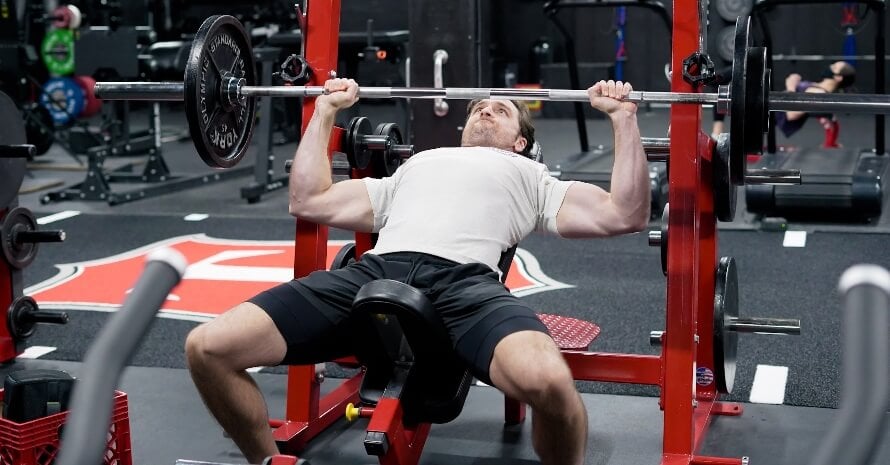
Push day workouts train the main upper body muscles involved in pushing things away from your torso: The chest, shoulders, and triceps. Typically, they emphasize compound pushing exercises (those that train multiple muscle groups simultaneously), including the flat and incline barbell bench press and overhead press.
They also often include isolation exercises (those that train one muscle group at a time) to target the parts of your pushing muscles that compound push exercises train less effectively.
Push day workouts are usually part of a “push pull legs” or “push pull legs upper lower” split. These are programs that dedicate entire workouts to training a specific “movement” (e.g., pushing) or area of your body (e.g., your legs).
READ MORE: An Expert Guide to the Push Pull Legs Upper Lower (PPLUL) Split
Muscles Worked in a Push Day Workout
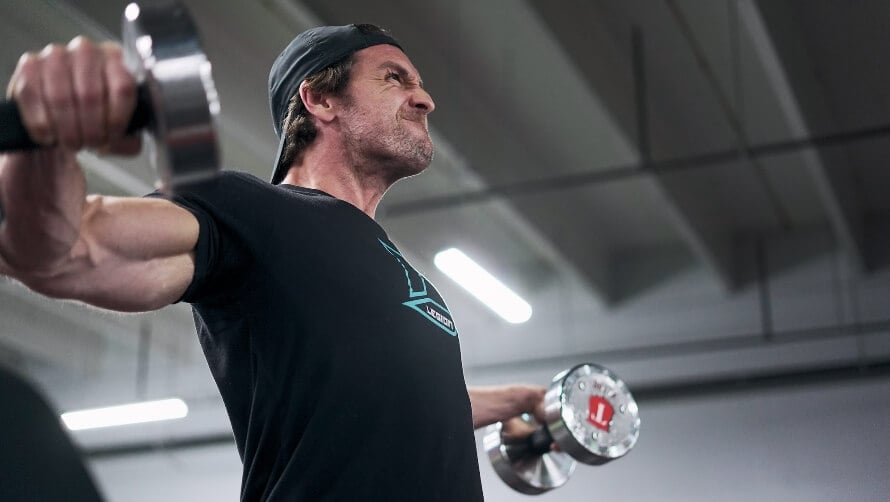
The main muscle groups worked in a push day workout are:
- Chest
- Shoulders
- Triceps
Here’s how these muscles look on your body:
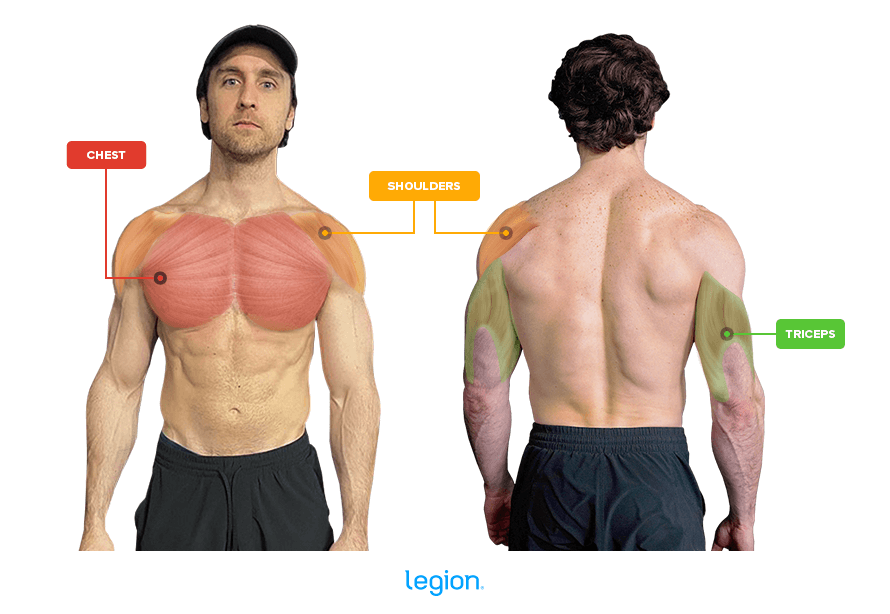
The Best Push Day Workout for Size and Strength
The following push day workout is designed to help you gain chest, shoulder, and triceps size and strength fast.
It works because it contains only the most effective push day exercises—each one trains your pushing muscles through large ranges of motion, allows you to lift heavy weights, and makes it easy to apply progressive overload.
It also contains the perfect amount of volume (sets) to stimulate growth without causing excessive fatigue.
That said, this is a demanding routine. To get the best results without burning out, run it once per week for 8-to-10 weeks, take a deload, then swap it for a lower-volume push workout for another 8-to-10 weeks. Once you’re fully recovered, switch back to this routine to kickstart growth again:
- Bench Press: 3 sets | 4-to-6 reps | 3-to-5 min rest
- Overhead Press: 3 sets | 4-to-6 reps | 3-to-5 min rest
- Incline Dumbbell Bench Press: 3 sets | 4-to-6 reps | 3-to-5 min rest
- Dip: 3 sets | 6-to-8 reps | 2-to-3 min rest
- Dumbbell Side Lateral Raise: 3 sets | 6-to-8 reps | 2-to-3 min rest
- Overhead Triceps Extension: 2 sets | 6-to-8 reps | 2-to-3 min rest
Now let’s look at how to perform each exercise and why they’re so effective.
Push Day Exercise List
1. Barbell Bench Press
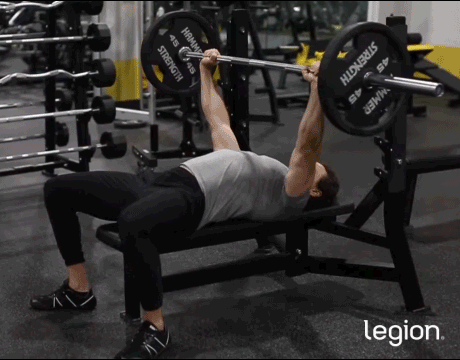
Why: Any good push day workout routine revolves around the bench press because it allows you to handle heavy weights, progress regularly, and train almost every major muscle in your upper body, particularly your pecs, triceps, and deltoids.
How to:
- Lie on a flat bench and place your feet flat on the floor.
- Pull your shoulder blades together and down, and without lifting your butt or shoulders off the bench, slightly arch your back.
- Grab the bar with a slightly wider than shoulder-width grip and unrack the barbell.
- Lower the barbell to your chest, keeping your elbows tucked 6-to-8 inches from your sides.
- Press the bar back to the starting position.
Alternatives:
- Incline Barbell Bench Press
- Dumbbell Bench Press
- Close-Grip Bench Press
2. Overhead Press
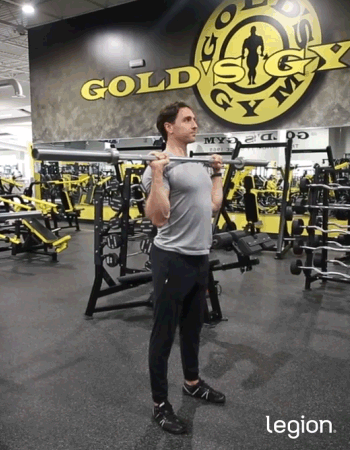
Why: The overhead press is a fantastic push day exercise for adding mass to your shoulders, upper back, and upper chest. Because it requires whole-body balance and coordination, it also trains stabilizer muscles throughout your entire body.
How to:
- Set a barbell in a rack at the same height as your upper chest.
- Grip the bar with a shoulder-width grip and your palms facing away from you.
- Unrack the barbell, step backward, and plant your feet just outside of shoulder width.
- Push the bar toward the ceiling until your arms are straight.
- Reverse the movement and return to the starting position.
Alternatives:
- Seated Overhead Press
- Shoulder Press
- Arnold Press
3. Incline Dumbbell Bench Press
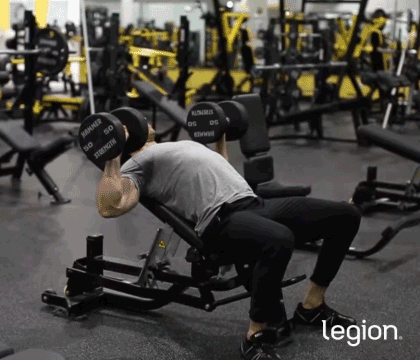
Why: The incline dumbbell bench press deserves a place in every good push day workout because it emphasizes your “upper pecs,” which is crucial for developing a full, balanced chest. It also allows you to train through a slightly larger range of motion than the barbell version, which likely benefits growth.
How to:
- While lying on a bench angled at 30-to-45 degrees, hold a dumbbell in each hand and rest them on your thighs.
- Lie back, hoisting the dumbbells up so you’re holding them on either side of your chest by giving them a nudge with your thighs.
- Press the dumbbells over your upper chest until your arms are straight and your elbows are locked.
- Lower the dumbbells to the starting position.
Alternatives:
- Incline Barbell Bench Press
- Close-Grip Bench Press
- Dumbbell Bench Press
4. Dip
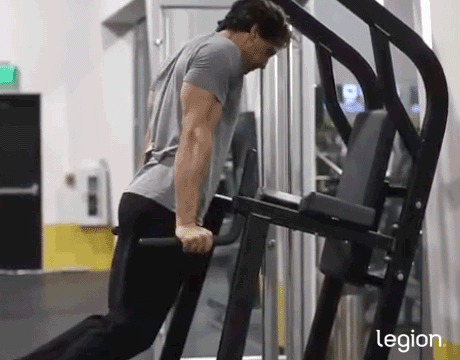
Why: The dip trains your pecs through a full range of motion and while deeply stretched, which benefits growth. It also likely trains the lower pecs slightly better than other chest exercises, so it’s useful push day exercise for rounding out pec development.
How to:
- If you’re using a dip belt, wrap the chain around your waist, add the desired amount of weight to the chain, and fasten the carabiner.
- Grab both handles of a dip station, then press yourself up by straightening your arms and gently jumping off the ground so your arms are straight and supporting your entire body weight.
- Slightly bend your knees to keep your feet from touching the ground, then lower your body by bending your elbows until your upper arms are roughly parallel to the floor.
- Reverse the movement and return to the starting position.
Alternatives:
- Close-Grip Bench Press
- Neutral-Grip Dumbbell Bench Press
- Dumbbell Pullover
5. Dumbbell Side Lateral Raise
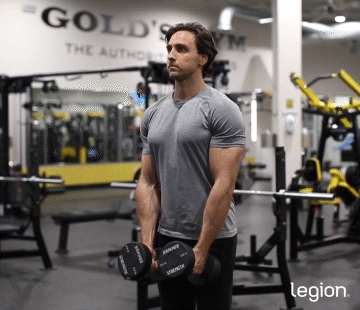
Why: The dumbbell side lateral raise is an excellent push day exercise for isolating the lateral (side) head of the deltoids, which is important if you want to develop wide, proportional shoulders.
How to:
- Stand up straight with a dumbbell in each hand.
- Raise the dumbbells out to your sides until your upper arms are parallel to the floor.
- Reverse the movement and return to the starting position.
Alternatives:
- Cable Side Lateral Raise
- Barbell Upright Row
- Cable Upright Row
6. Overhead Triceps Extension
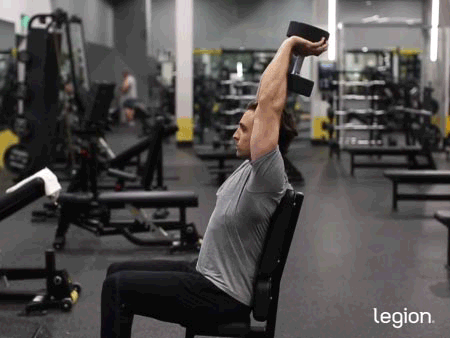
Why: For a highly effective push day exercise for the triceps, look no further than the overhead triceps extension. It trains the entire triceps while stretched, which may help maximize growth. It also emphasizes the triceps long head, which is the section of the triceps most responsible for adding mass to your arms.
How to:
- Sit up straight on a bench.
- Grip one end of a dumbbell using both palms and lift it overhead so your arms are straight. Your palms should be flat against the end of the dumbbell and facing the ceiling.
- Lower the weight until it’s behind your head by bending your elbows, then straighten your arms and return to the starting position.
Alternatives:
- Dip
- Skullcrusher
- Triceps Pushdown
What Are the Benefits of Push Day Workouts?
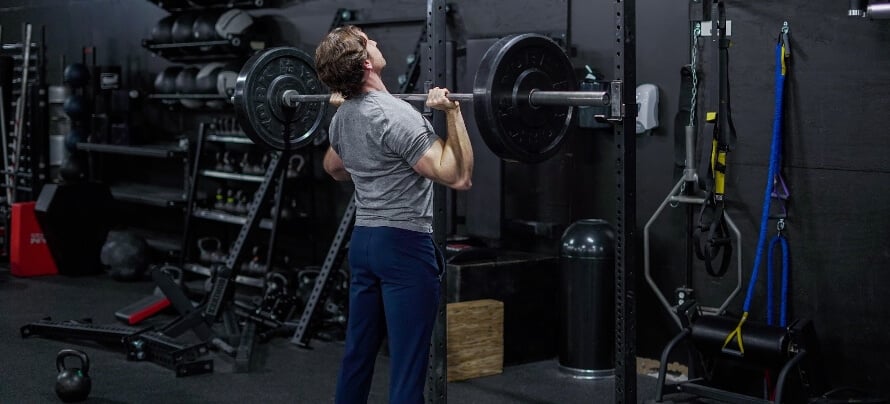
Here are three reasons push day workouts are one of the most effective ways to build upper body muscle and strength.
Time Efficiency
Push day routines train your chest, shoulders, and triceps in one session, eliminating the need for separate workouts for each muscle group and making it ideal for those with limited time.
Higher-Quality Training
When you train one muscle group per workout, its performance decreases as the workout progresses. To compensate, you have to use lighter weights or do fewer reps, which isn’t ideal for muscle and strength gain. Push day workouts avoid this issue by distributing the effort across several muscle groups.
Less Soreness
Since you never train any single muscle group to the point of exhaustion, most people find they’re less sore from push day workouts and can recover faster, making it easier to maintain training intensity across the week without one session negatively affecting the next.
5 Tips for More Productive Push Day Workouts
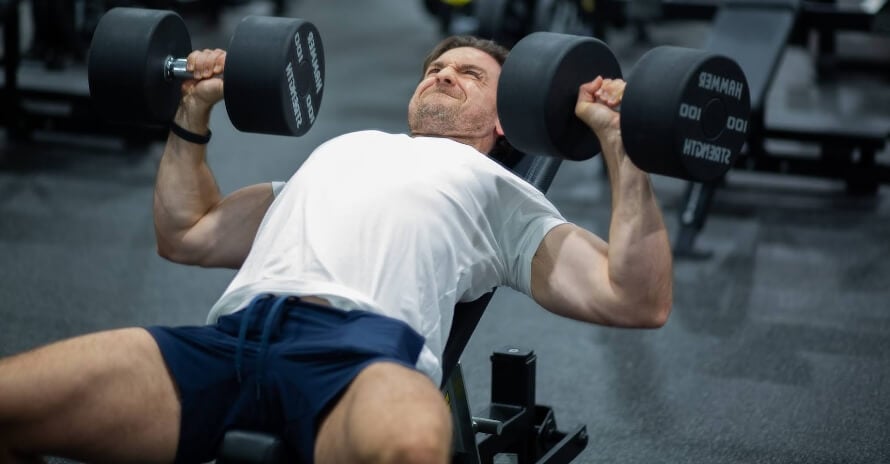
Maximize your push day results with these five simple tips.
1. End every set 1-to-3 reps shy of muscle failure.
As I explain in my fitness books for men and women, to maximize your results, you must take most of the sets in your push workouts to within a rep or two of failure.
Ask yourself at the end of each set, “If I had to, how many more reps could I have gotten with good form?” If the answer is more than two, increase the weight or reps to make your next set more challenging.
READ MORE: Does Training to Failure Help You Build More Muscle? What Science Says
2. Once you hit the top of your rep range for a set, move up in weight.
If your push workout calls for 4-to-6 reps of the bench press and you get 6 reps for a set, add 10 pounds to your next set.
If you manage 3 or fewer reps with the new weight, reduce the weight by 5 pounds to ensure you stay in the 4-to-6 rep range.
Follow this pattern of trying to add reps or weight to every exercise in every workout.
READ MORE: Double Progression Guide: How to Use Double Progression to Gain Muscle and Strength
3. Eat enough calories and protein.
To maximize muscle and strength gain while following this push day workout routine, maintain a daily calorie surplus of around 110% of your total daily energy expenditure (TDEE). In other words, eat around 10% more calories than your body burns daily.
You also need to eat enough protein to allow your muscles to recover, repair, and grow effectively. Aim to eat at least one gram of protein per pound of body weight per day.
For personalized advice about exactly how many calories to eat, how much of each macronutrient, and which foods you should consume to reach your fitness goals, take the Legion Diet Quiz.
4. Track your workouts.
Tracking your workouts keeps you focused, motivated, and moving forward. If you’re not writing things down, you’re basically guessing your way through every session—guessing how much weight to lift, how many reps to aim for, and whether you’re actually improving.
And that’s a recipe for spinning your wheels.
To keep it simple, use a notebook or the notes app on your phone. Log each exercise, the rep range, and how many reps you hit per set. For example:
Push Day Workout 04/24/2025
Barbell Bench Press (4-to-6 reps)
- Set 1: 5 reps
- Set 2: 4 reps
- Set 3: 4 reps
Before each push day workout (or any workout for that matter), check your previous numbers and aim to beat them—whether by adding a rep, increasing the weight, or improving your form.
You can also jot down how you felt, if anything hurt, or other notes that might explain your performance. These details help you train smarter over time.
5. Take the right supplements.
These supplements can help you optimize your push day workout performance and gains:
- Protein powder: Protein powder, such as whey or casein, provides your body with the nutrients needed to build muscle tissue and recover from workouts. For a clean and delicious protein powder, try Whey+ or Casein+.
- Creatine: Creatine boosts muscle and strength gain, improves anaerobic endurance, and reduces muscle damage and soreness from your workouts. For a natural source of creatine, try our creatine monohydrate, creatine gummies, or Recharge.
- Pre-workout: A high-quality pre-workout enhances energy, mood, and focus, increases strength and endurance, and reduces fatigue. For a top-tier pre-workout containing clinically effective doses of 6 science-backed ingredients, try Pulse with caffeine or without.
(If you’d like even more specific advice about which supplements you should take to reach your health and fitness goals, take the Legion Supplement Finder Quiz, and in less than a minute, you’ll know exactly what supplements are right for you.)
FAQ #1: Is doing 6 exercises enough for a push day workout?
It depends on how many sets you’re doing for each exercise. If you’re doing 2-to-3 sets per exercise, 6 is more than enough. If you’re doing more than 3 sets per exercise, 6 exercises is likely overkill.
An unpublished meta-analysis suggests there’s a cap on how many sets you can do for a muscle group in a single workout before it starts doing more harm than good. Here’s a graph to illustrate this:

As the graph shows, muscle growth improves as you do more sets—up to a point. Once you go beyond six sets for a muscle group in a single session, the benefits plateau. And if you push to around 14 sets, it may even hinder muscle growth.
That said, the data has a lot of variability, so it’s best used as a guideline rather than gospel. If we compare it with other research, a good rule of thumb is that most people can benefit from doing about 6-to-10 hard sets per major muscle group per workout before hitting the point of diminishing returns.
In the push day workout in this article, you do:
- 9 sets for chest, which is near the high end of the effective range
- 6 sets for shoulders, plus additional indirect volume from chest exercises
- 2 direct sets for triceps, plus indirect volume from all chest and shoulder exercises
That’s a high—but effective—amount of training volume. Just make sure to deload after 8-to-10 weeks, then switch to a lower-volume push day routine for the following 8-to-10 weeks to give your body a break.
READ MORE: How Many Sets Should You Do for Muscle Hypertrophy?
FAQ #2: What’s a good push day workout for women?
The push day workout in this article works just as well for women as it does for men. That said, many women care less about building large pecs and more about developing defined shoulders and arms, so it may make sense to tailor your training to reflect these priorities.
Another tweak worth considering is rep range. While everyone is different, women often prefer to train in slightly higher rep ranges than men. For them, higher-rep sets often feel more manageable and less intimidating than lower-rep sets.
With that in mind, here’s a push day workout that might be a better fit for some women:
- Overhead Press: 3 sets | 6-to-8 reps | 3-to-5 min rest
- Close-Grip Bench Press: 3 sets | 6-to-8 reps | 2-to-3 min rest
- Incline Dumbbell Bench Press: 3 sets | 6-to-8 reps | 3-to-5 min rest
- Overhead Triceps Extension: 3 sets | 8-to-10 reps | 2-to-3 min rest
- Dumbbell Side Lateral Raise: 3 sets | 8-to-10 reps | 2-to-3 min rest
- Triceps Pushdown: 3 sets | 8-to-10 reps | 2-to-3 min rest
Again, this isn’t necessarily better for all women all the time. If these changes align with your goals and preferences—say, you’d rather focus on your shoulders than your chest—then give this variation a go. If not, the original push day workout outlined earlier is still a great choice.
FAQ #3: What’s a good push day workout at home?
Here’s a simple at-home push day workout for building muscle with no equipment. For best results, push each set 1-to-2 reps shy of failure:
- Handstand Push-up: 4 sets | 4-to-10 reps | 3-to-5 min rest
- Feet-Elevated Push-up: 4 sets | 10-to-30 reps | 3-to-5 min rest
- Diamond Push-up: 4 sets | 10-to-30 reps | 3-to-5 min rest
Scientific References +
- Bloomquist, K., et al. “Effect of Range of Motion in Heavy Load Squatting on Muscle and Tendon Adaptations.” European Journal of Applied Physiology, vol. 113, no. 8, 20 Apr. 2013, pp. 2133–2142, link.springer.com/article/10.1007%2Fs00421-013-2642-7, https://doi.org/10.1007/s00421-013-2642-7.
- Oranchuk, Dustin J., et al. “Isometric Training and Long-Term Adaptations: Effects of Muscle Length, Intensity, and Intent: A Systematic Review.” Scandinavian Journal of Medicine & Science in Sports, vol. 29, no. 4, 13 Jan. 2019, pp. 484–503, onlinelibrary.wiley.com/doi/full/10.1111/sms.13375, https://doi.org/10.1111/sms.13375.
- Ochi, Eisuke , et al. Higher Training Frequency Is Important for Gaining Muscular Strength under Volume-Matched Training. 1 July 2018, www.frontiersin.org/journals/physiology/articles/10.3389/fphys.2018.00744/full, https://doi.org/10.3389/fphys.2018.00744.
- Helms, Eric R, et al. “Evidence-Based Recommendations for Natural Bodybuilding Contest Preparation: Nutrition and Supplementation.” Journal of the International Society of Sports Nutrition, vol. 11, no. 1, 12 May 2014, https://doi.org/10.1186/1550-2783-11-20.
- Stokes, Tanner, et al. “Recent Perspectives Regarding the Role of Dietary Protein for the Promotion of Muscle Hypertrophy with Resistance Exercise Training.” Nutrients, vol. 10, no. 2, 7 Feb. 2018, p. 180, www.mdpi.com/2072-6643/10/2/180/pdf.
- Eckerson, Joan M., et al. “Effect of Creatine Phosphate Supplementation on Anaerobic Working Capacity and Body Weight after Two and Six Days of Loading in Men and Women.” The Journal of Strength and Conditioning Research, vol. 19, no. 4, 2005, p. 756, https://doi.org/10.1519/r-16924.1.
- Bassit, Reinaldo Abunasser, et al. “Effect of Short-Term Creatine Supplementation on Markers of Skeletal Muscle Damage after Strenuous Contractile Activity.” European Journal of Applied Physiology, vol. 108, no. 5, 3 Dec. 2009, pp. 945–955, https://doi.org/10.1007/s00421-009-1305-1.
- “Set Volume for Muscle Size: The Ultimate Evidence Based Bible.” Weightology, weightology.net/the-members-area/evidence-based-guides/set-volume-for-muscle-size-the-ultimate-evidence-based-bible/.










